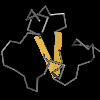?
 
PHD finger found in inhibitor of growth protein 1 (ING1) and 2 (ING2) ING1 is an epigenetic regulator and a type II tumor suppressor that impacts cell growth, aging, apoptosis, and DNA repair, by affecting chromatin conformation and gene expression. It acts as a reader of the active chromatin mark, the trimethylation of histone H3 lysine 4 (H3K4me3). It binds and directs Growth arrest and DNA damage inducible protein 45 a (Gadd45a) to target sites, thus linking the histone code with DNA demethylation. It interacts with the proliferating cell nuclear antigen (PCNA) via the PCNA-interacting protein (PIP) domain in a UV-inducible manner. It also interacts with a PCNA-interacting protein, p15 (PAF). Moreover, ING1 associates with members of the 14-3-3 family, which is necessary for cytoplasmic relocalization. Endogenous ING1 protein specifically interacts with the pro-apoptotic BCL2 family member BAX and colocalizes with BAX in a UV-inducible manner. It stabilizes the p53 tumor suppressor by inhibiting polyubiquitination of multi-monoubiquitinated forms via interaction with and colocalization of the herpesvirus-associated ubiquitin-specific protease (HAUSP)-deubiquitinase with p53. It is also involved in trichostatin A-induced apoptosis and caspase 3 signaling in p53-deficient glioblastoma cells. In addition, tyrosine kinase Src can bind and phosphorylate ING1 and further regulates its activity. ING2, also termed inhibitor of growth 1-like protein (ING1Lp), or p32, or p33ING2, belongs to the inhibitor of growth (ING) family of type II tumor suppressors. It is a core component of a multi-factor chromatin-modifying complex containing the transcriptional co-repressor SIN3A and histone deacetylase 1 (HDAC1). It has been implicated in the control of cell cycle, in genome stability, and in muscle differentiation. ING2 independently interacts with H3K4me3 (Histone H3 trimethylated on lysine 4) and PtdIns(5)P, and modulates crosstalk between lysine methylation and lysine acetylation on histone proteins through association with chromatin in the presence of DNA damage. It collaborates with SnoN to mediate transforming growth factor (TGF)-beta-induced Smad-dependent transcription and cellular responses. It is upregulated in colon cancer and increases invasion by enhanced MMP13 expression. It also acts as a cofactor of p300 for p53 acetylation and plays a positive regulatory role during p53-mediated replicative senescence. Both ING1 and ING2 contain an N-terminal ING domain and a C-terminal plant homeodomain (PHD) finger. |
